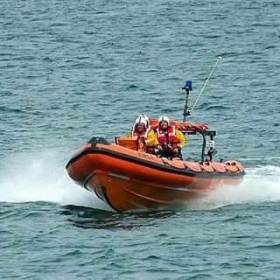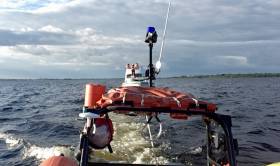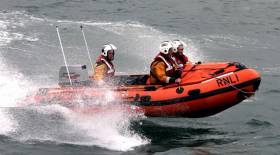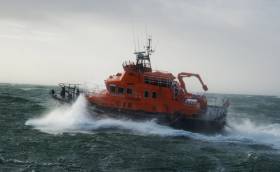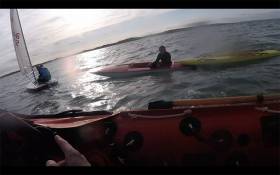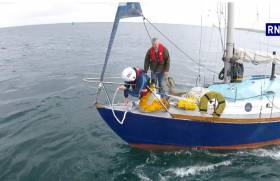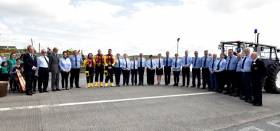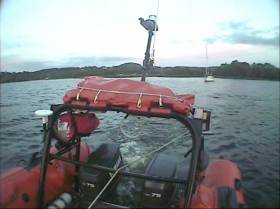Displaying items by tag: Lifeboat
Baltimore RNLI carried out a medical evacuation yesterday afternoon (Sunday 23 July) after a man sustained injuries while on a visit to Sherkin Island off the coast of West Cork.
The volunteer lifeboat crew was requested to launch their inshore lifeboat following a request from the Irish Coast Guard at 4.13pm and were on scene in seven minutes. The man had cut his foot on a sharp object while out walking on Bán Strand on Sherkin Island.
Once on scene, two of the volunteer crew went ashore and administered casualty care before transferring the injured man to the inshore lifeboat. He was brought back to Baltimore lifeboat station at and handed over to the care of HSE Ambulance crew who were waiting at the station.
The lifeboat was helmed by Pat O’Driscoll and with crew members Jerry Smith and Colin Rochford and shore crew in attendance were Tom Kelly, Seamus O’Driscoll and Kate Callanan.
Speaking following the call out, Kate Callanan, Baltimore RNLI Volunteer Lifeboat Press Officer said: ‘In this incident with the considerable distance between the beach and the ferry pier and the nature of the man’s injuries, a medical evacuation by lifeboat was the best course of action. The man did the right thing in requesting assistance from the Coast Guard. Remember, if you get into difficulty anywhere along the coastline, call 999 or 112 and ask for the Coast Guard. We wish him a speedy recovery.’
On Saturday July 22, Valentia Coast Guard requested Lough Derg RNL to assist two people and their dog after their 38ft cruiser ran aground at Ryan’s Point, on the eastern shore of Lough Derg.
At 2.35pm the lifeboat was launched with helm Eleanor Hooker, Keith Brennan and Darragh Quinn on board. Winds were northeasterly, Force 2. Visibility was good.
Both passengers and their dog were found to be safe and unharmed and wearing their lifejackets. The RNLI made numerous attempts to take the cruiser off the rocks, but it was stuck fast. The RNLI volunteer crew decided to take both people and their dog to Dromineer and to arrange for the cruiser to be lifted off the rocks by a specialist crew from the local marina. They informed Valentia Coast Guard of their decision.
The lifeboat returned to station and was ready for service again at 4.32pm.
At 7.22pm, the lifeboat launched following a request from Valentia Coast Guard to assist four people in a 40ft cruiser with engine failure by the Goat Road, at the northern end of Lough Derg. At 7.40pm the lifeboat, with helm Eleanor Hooker, Owen Cavanagh and Kevin Dooley on board, located the cruiser adrift on the navigation route. The wind was northerly, F2/3.
The lifeboat took the vessel on an astern tow to Dromineer Bay, where the lifeboat volunteers changed the tow to an alongside tow before bringing the boat into Dromineer Harbour.
Once the cruiser was safely tied up alongside at Dromineer, the lifeboat returned to Station and was read for service again at 9.07pm
Brendan O’Brien, Deputy Launching Authority at Lough Derg RNLI Lifeboat Station, advises all boat users on the lake, to ‘bring charts of the lake in addition to electronic systems of navigation, and plan a safe passage before leaving harbour’.
Fethard RNLI Responds to False Alarm with Good Intent
Fethard RNLI launched its inshore lifeboat yesterday evening (Thursday 6 July) to conduct a search after a member of the public reported seeing a kayak floating in the sea off Duncannon Beach in County Wexford.
The volunteer crew was requested to launch their inshore lifeboat at 7.50pm. They quickly assembled at the station and the lifeboat immediately proceeded to an area north of Broom Hill to carry out a search.
Weather conditions at the time were good with a light northerly Force 3 wind and a slight to moderate sea.
The crew located the kayak with no one onboard before continuing a search from Broomhill north to Duncannon, west to Woodstown, and back south to Creaden Head and east to Templetown. This was followed by a search from Templetown to Dollar Bay.
Meanwhile, the Fethard Coast Guard unit carried out a search of the shore while the Irish Coast Guard helicopter, Rescue 117 from Waterford conducted a search from the air.
The search was stood down after it was confirmed that the owner of the kayak had been safely located after swimming back to shore.
Speaking following the call out, Hugh Burke, Fethard RNLI Deputy Launching Authority said: ‘While the call out turned out to be a false alarm with good intent, we would like to commend the member of the public who raised the alarm when they saw the kayak. They thought someone was in difficulty and that was absolutely the right thing to do.
‘The search proved to be a great example of interagency work between ourselves and our colleagues in the Irish Coast Guard.
‘We would remind anyone planning a trip to sea this summer to always respect the water. Always wear a lifejacket and carry a means of communication. Should you get into difficulty call 999 or 112 and ask for the Coast Guard. If you lose a kayak or a board, please report it to the Coast Guard or the Gardaí.’
Rosslare Harbour RNLI has rescued three men this afternoon after their motorboat encountered mechanical problems and broke down off the Wexford coast.
The volunteer crew was requested to launch their all-weather lifeboat at 3pm following a report from the Irish Coast Guard that the vessel was in difficulty eight miles north east of Rosslare Harbour.
The lifeboat under Coxswain Eamon O’Rourke and with six crew members onboard launched immediately and made its way to the scene. The sailors had been on passage from Dun Laoghaire to Kilmore Quay when they began to encounter problems.
Weather conditions were good at the time with a slight westerly wind.
Once on scene at 3.30pm, the lifeboat crew stood by as the sailors got their vessel started again. The lifeboat then escorted the motorboat safely back to Rosslare Harbour.
Speaking following the call out, David Maloney, Rosslare Harbour RNLI Lifeboat Operations Manager said: ‘Sailing and motorboating are popular pastimes and particularly so at this time of year. We would remind sailors and anyone taking to sea to always wear a lifejacket. Always have a means for calling or signalling for help and ensure everyone onboard knows how to use it. Always check the weather forecast and tide times and make sure someone ashore knows where you are going and who to call if you don’t return on time. And should you get into trouble, dial 999 or 112 and ask for the Coast Guard. The RNLI provides a 24 hour search and rescue service and our volunteers at Rosslare Harbour are always ready and willing to help.’
Howth RNLI Rescue Two Dinghy Sailors in Difficulties
Howth RNLI launched the inshore lifeboat Saturday 1st July to reports of 2 dinghy sailors finding it difficult to return to Portmarnock beach in heavy offshore winds.
The inshore lifeboat was tasked at 7.25pm to the scene just off Portmarnock beach and located a Grandfather, his grand-daughter and a lifeguard from the beach in separate dinghies trying to sail back to the shore against strong winds. The smaller dinghy was dismasted and under tow from the larger laser type dinghy.
As the young girl was showing signs of cold and fatigue the volunteer lifeboat crew called for an ambulance to meet them at the beach.
The casualties were taken aboard the lifeboat and the sailing dinghies taken in tow back to the beach where the young girl was met by her Father who had raised the alarm. Both sailors were treated and checked by the ambulance crew on arrival.
The wind was Force 5 and the sea state was moderate at the time
Speaking following the call out, Stephen Harris, Howth RNLI DLA said: ‘We were delighted to assist the sailors after they found themselves in difficulty. The Father had quickly radioed for assistance which was the correct thing to do and we were able to launch and bring the sailors to safety.’
Larne RNLI Launches Five Times in a Fortnight, Incidents Include a Broken Down Yacht & Vessels Taking on Water
The most recent launch took place on Friday last, 23 June at 11pm. Larne's all-weather lifeboat Dr John McSparron and inshore lifeboat Terry launched on request of Belfast Coastguard to reports of two overdue kayakers. Both boats completed a search north from Larne with the kayakers located safe and well at Drumnagreagh.
Larne RNLI launched both lifeboats on Sunday 11 June to a 36ft yacht experiencing engine difficulties near the entrance to Larne Lough. On arrival, a volunteer lifeboat crew member was transferred onto the yacht to check the three on board were safe and well. A towline was then established before the lifeboat brought the yacht into the safety of Larne harbour.
Only 2 days later (Tuesday 13 June) Larne inshore lifeboat was launched following reports of an over-turned kayak at Carnfunnock. A multi-agency search took place but nothing was found indicating a false alarm with good intent.
The volunteer crew pagers sounded again on Sunday 18 June. Both Larne lifeboats launched to assist a vessel with two adults and two children on board that was taking on water in Drains Bay. The all-weather lifeboat was stood down by Belfast Coastguard after it was confirmed that the vessel had made it ashore. The inshore lifeboat continued to Carnfunnock to ensure no assistance was required and all onboard the vessel were safely ashore.
On Monday 19 June the lifeboat crew were requested to launch by Belfast coastguard at 8.40pm after reports that five teenagers were stranded on rocks at Blackarch. Larne RNLI immediately launched both lifeboats and was on scene within minutes. After putting the group into lifejackets, the lifeboat crew carefully transferred them onboard the inshore lifeboat. They then made the short trip out to the all-weather lifeboat where they were then transferred onboard and their condition assessed. Members of the Larne Coastguard were also on scene and provided valuable ground support during the operation.
Larne RNLI Coxswain Frank Healy said: 'This has been a busy few weeks for our volunteer crew who drop everything to answer the call when their pagers sound. Our crews are highly trained and skilled, and excellent team work ensured that all five launches were completed safely and successfully.'
Coming into the summer season the RNLI is promoting its national drowning prevention campaign, Respect the Water. It is aimed at promoting safety advice to all who visit the coast. The RNLI want everyone to enjoy the water, but also want people to recognise its dangers and never underestimate its power. This year, Respect the Water will focus on simple floating skills that could save a life. If you find yourself unexpectedly in the water, he advice is to float to increase your chances of survival. If you see someone else in trouble in the water, call 999 or 112 and ask for the Coastguard.
Allan Dorman, Larne RNLI Lifeboat Operations Manager advises: ‘For those who are planning to visit the sea please check the weather and tides before heading to the coast, tell someone where you're going and when you expect to be back. Wear a lifejacket and always carry a means of calling for help. And if you see someone in danger in the water, call 999 and ask for the Coastguard.’
Larne RNLI launched their all-weather lifeboat Dr John McSparron and inshore lifeboat Terry this afternoon (Sunday 11 June) to a 36ft yacht experiencing engine difficulties near the entrance to Larne Lough.
The all-weather lifeboat under Coxswain Frank Healy launched at 1.15pm and made its way to the scene north of the Port of Larne’s number one buoy. On arrival, a volunteer lifeboat crew member transferred onto the yacht where he first checked that the three on board were safe and well. The gear box onboard the yacht was broken and weather conditions presenting a force 3-4 southerly wind meant the crew of the vessel were unable to sail safely back to their mooring in Larne Lough.
The lifeboat crew established a towline before the lifeboat brought the yacht into the safety of Larne harbour. The all-weather lifeboat was met by the station’s inshore lifeboat which assisted to place the boat safely on the mooring.
Speaking following the call out, Larne RNLI Coxswain Frank Healy said: ‘All the crew training was put into action today to carry out a safe and efficient rescue. An excellent team effort ensured that the tow line was set up speedily and the yacht with two adults and a child onboard was safely on its mooring without delay.’
The Duke of Kent visited Kilrush RNLI yesterday afternoon as part of a two-day tour of lifeboat stations in Tipperary, Clare and Kerry. The Duke has been President of the RNLI since 1969.
The Duke of Kent arrived at Kilrush Lifeboat Station shortly after 03:00pm, where His Royal Highness was greeted by the volunteer lifeboat operations team, lifeboat crew members and the local fundraising branch.
As part of the visit, Kilrush RNLI showcased local Irish dancing, the Irish Whale & Dolphin Group, handcrafted traditional Irish Currach building, and a selection of local pottery from the Brothers of Charity. Also, in attendance were representatives from Kilrush GAA which focused on the partnership between the GAA and RNLI working together to prevent drowning.
To conclude, a beautiful Irish Yew tree was planted at Kilrush lifeboat station to honour the visit, followed by a brief launch and recovery of Kilrush RNLI’s Atlantic 85 lifeboat.
Commenting on the event, Pauline Dunleavy, Kilrush Lifeboat Operations Manager said: ‘It was an honour to welcome His Royal Highness to Kilrush lifeboat station. We are very proud of our station delighted to host the President of the RNLI. We showcased our great team, as well as great community spirit. In particular, I would like to thank Kilrush GAA for attending. Much like a lifeboat station, a GAA club is at the heart of community life, and through this partnership we all can both play a major role in preventing deaths by drowning.”
Lough Derg RNLI Lifeboat launched to assist 2 people after their 26ft–yacht went aground below Coolbawn on Lough Derg
At 8.30pm Saturday, May 27, Valentia Coast Guard requested Lough Derg RNLI Lifeboat to launch to assist 2 people after their 26ft yacht went aground below Coolbawn on the Tipperary shore of Lough Derg.
At 8.40pm, the lifeboat launched with helm Eleanor Hooker, Owen Cavanagh and Delia Ho on board. Winds was north-westerly, Force 4/5. Visibility was good but with dusk imminent.
The lifeboat located the casualty vessel at 8.55pm. Two RNLI volunteers waded in to the casualty vessel, which was on a rocky shoal in 2ft of water. Both passengers were found to be safe and unharmed and wearing their lifejackets. The RNLI volunteers checked the boat and once satisfied that it was not holed, set up bridle and tow. One RNLI crew member remained on board and the other returned to the lifeboat. The vessel was taken gently off the rocks and towed into deep water, where the lifeboat removed the tow and the yacht made way using its outboard motor.
However, after a short period, their outboard motor failed. The lifeboat came alongside and transferred a crew member across, where he helped refuel, prime and vent their fuel tank. The lifeboat remained with the yacht and her crew until she was tied safely alongside at Kilgarvin Harbour.
Liam Maloney, Lifeboat Operations Manager at Lough Derg RNLI Lifeboat, advises boat users to ‘bring charts with you and identify the areas close to shore and islands marked as not navigable’. He commended the crew of the yacht for carrying a spare tank of fuel on board.
The lifeboat returned to station and was ready for service again at 11.00pm.
Rosslare Harbour RNLI all weather was launched by the volunteer lifeboat crew yesterday morningat 11.45am to respond to an EPIRB distress signal (Emergency Position Indicating Radio Beacon).
The Irish Coast Guard alerted Rosslare Harbour RNLI to immediately launch following an EPIRB alarm, which usually indicates a vessel in serious danger. The signal was traced to an 18m yacht close to Carnsore Point off the Wexford coast, which was competing in the offshore Normandy Channel yacht race, as reported by Afloat.ie here.
The RNLI lifeboat and Coast Guard helicopter Rescue 117 were quickly on the scene. It was soon established that the 18m yacht was not in trouble and the EPIRB alarm had accidentally activated. Volunteer RNLI crew aboard Rosslare Harbour lifeboat deactivated the alarm system, returned the device to the yacht which then continued on with its race.
Conditions at the time were reasonably favourable with a brisk southerly wind.
Speaking after the incident Rosslare Harbour RNLI Volunteer Lifeboat Press Officer Jamie Ryan praised the skill of the coxswain who brought the lifeboat alongside the yacht and the efforts of the RNLI volunteers who fixed the EPIRB and returned it to the 18m yacht.




























